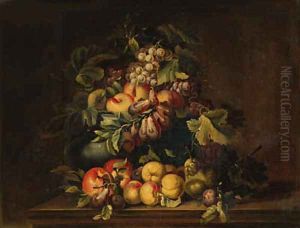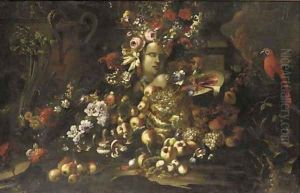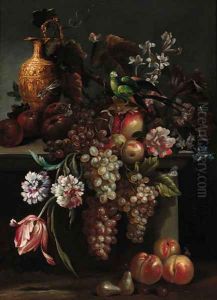Giovanni Paolo Castelli, Called Spadino Paintings
Giovanni Paolo Castelli, known as Spadino, was an Italian painter born in 1659 in Rome. He is recognized primarily for his still-life paintings, which often featured fruit and flowers. Castelli was a part of the European still-life painting tradition, which focused on the detailed and realistic representation of inanimate objects, often imbued with symbolic meanings.
Spadino was born into an artistic family, which played a significant role in his early artistic development. His father, Bernardo Castelli, was a painter as well, and it is believed that Giovanni Paolo received his initial training in his father's workshop. He was also influenced by the works of Caravaggio and the Caravaggisti, who were known for their dramatic use of light and shadow, a technique that Spadino adopted and adapted in his own compositions.
During his career, Spadino became well-known for his ability to paint with a high level of detail and his skill in capturing the textures and colors of different natural elements. His compositions often included a variety of objects such as fruits, flowers, and sometimes small animals, all arranged in a manner that was both aesthetically pleasing and rich in symbolism. Many of his paintings also held allegorical meanings, common to the Baroque period, reflecting themes of life, death, and the passage of time.
Spadino's work was well-received and he gained a reputation as a celebrated still-life painter in Rome. His paintings were sought after by wealthy patrons, including members of the papal court. Despite the popularity of his work during his lifetime, Spadino's name did not maintain the same level of recognition as some of his contemporaries in the centuries that followed.
Giovanni Paolo Castelli died in 1730 in Rome. Today, his paintings can be found in various art collections and museums around the world. They are valued for their contribution to the still-life genre and provide insight into the artistic and cultural milieu of Baroque Italy. Spadino's works continue to be studied and appreciated for their beauty and historical significance within the context of European art history.


